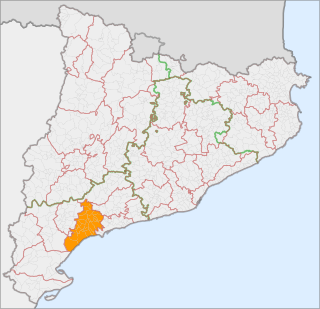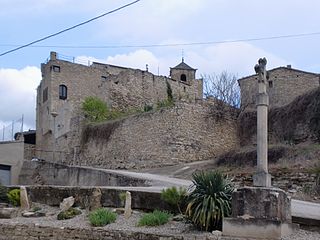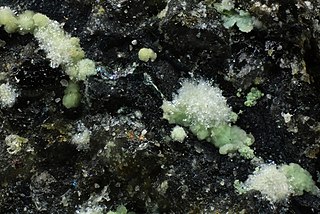
Joan Abella i Creus (Sabadell, Barcelona, 1968) is a Catalan gemmologist and mineralogist who discovered abellaite, a mineral that receives this name in his honor

Joan Abella i Creus (Sabadell, Barcelona, 1968) is a Catalan gemmologist and mineralogist who discovered abellaite, a mineral that receives this name in his honor
In 2008, he published his first book, "Minerals i Mines de la conca minera de Bellmunt del Priorat", a unique work in the Catalan town of Bellmunt del Priorat, never before described. It consists of three parts: the first is a well-illustrated discussion of the history of mining in the area from the proto-Iberian era to the present. The second part describes most of the important mines, as well as the methods of profit used. The third part is a description of the minerals that have been found there, accompanied by 100 photos of mineral samples from their own collection. [1]
He has also collaborated in the publication of several books, such as "Atlas de Asociaciones Minerales en láminas Prima" by Professor Joan Carles Melgarejo, "Minerales de España" by Joaquín Mollfulleda, "Minerales y Minas de España" by Miguel Calvo, and "Els Minerals de Catalunya" by Eugeni Bareche. He also collaborated on the work "Minerales y Piedras Preciosas", published in Madrid in 1994.
He has written several articles for various magazines specialized in mineralogy, such as the magazine "Mineralogists de Catalunya", published by the "Grup Mineralògic Català", or "Bocamina", published by the Mineralógico Group of Madrid. Does the article "Anthropogenic Silver?" who wrote about the silver of the Balcoll mine in Falset (Tarragona), a mine exploited since the fourteenth century by the Counts of the Mountains of Prades and lords of the Barony of Entenza, [2] which describes as specimens of acantite can be used to create samples of silver wire made by man, it was translated immediately into several other languages. [1] The silver crystals of this place are the best specimens obtained in Spain due to their aesthetic crystallization. [3]
One of the most significant contributions of Abella has been to increase the knowledge of the mineral heritage of the country, for having found, analyzed and published information on a variety of mineral species that had not previously been found in the territory. Some of these minerals are the xanthoconite of the Balcoll mine (Falset), the hopeite of La Cresta mine (Bellmunt del Priorat), the natronambulite of Joaquima mine (also in Bellmunt del Priorat), and arsenuranilite and čejkaite from the Eureka mine (Torre de Cabdella, Lleida). The discovery of this last species in the Torre de Cabdella was the second event in the world. [4] The finding of the breithauptite in the Balcoll mine also stands out, the best crystallized specimens of this species never to date anywhere in the world. [3]
In 2015, the International Mineralogical Association approved as a new species, the abellaite, named in this way in his honor. It was discovered at the Eureka mine, at Castell-estaó (La Torre de Cabdella, Lleida). This discovery was the first type locality in Catalonia, being the first mineral discovered in the territory. The type material, characterized by researchers from the Jaume Almera Earth Sciences Institute (CSIC) and the University of Barcelona, is deposited in the collections of the Museum of Natural Sciences of Barcelona, with the number of shows "MGB 26,350".

Priorat is a comarca (county) in Catalonia, Spain. The central part of the comarca, "Priorat històric," produces the highly regarded wines that are certified under the DOQ Priorat. Wines from elsewhere in the comarca are certified as DO Montsant although this region also has a small segment of the neighboring comarca, Ribera d'Ebre as well. However, galena mining was the main activity since prehistoric times until 1972, when the last galena mine closed.

Baix Camp is a comarca of Catalonia. It is one of the three comarques into which Camp de Tarragona was divided in the comarcal division of 1936.

Conca de Barberà is a comarca (county) in the province of Tarragona, Catalonia, Spain. Its total area is 650.24 km2 (251.1 sq mi). At its creation in 1936, it contained 23 municipalities, but in 1990, several of these were amalgamated; Rojals was combined with Montblanc, and Montbrió de la Marca was amalgamated with Sarral. Also in 1990, Vallfogona de Riucorb was moved from the Segarra comarca. This resulted in the current total of 22 municipalities.

Lluís Domènech i Montaner was a Spanish architect who was highly influential on Modernisme català, the Catalan Art Nouveau/Jugendstil movement. He was also a Catalan politician.

Catalonia is internally divided into eight regional divisions, known in Catalan as vegueries, following the regional plan of Catalonia. Each vegueria is further divided into comarques and municipalities, with the exception of the Aran Valley, considered a "unique territorial entity".

Vallfogona de Riucorb is a municipality and village in the comarca of the Conca de Barberà in central Catalonia, Spain. It is situated in the Comalats range in the north of the comarca, with the Cap de Cans rising to 759 m. Vallfogona village is built on the south bank of the Corb river.

Els Guiamets is a municipality in the comarca of the Priorat in Catalonia, Spain. It is situated in the south of the comarca. A local road links the village to the N-420 road between Falset and Móra la Nova. The Guiamets reservoir is on an affluent of the Siurana (Tarragona).

The Library of Catalonia is the Catalan national library, located in Barcelona, Catalonia, Spain. The primary mission of the Library of Catalonia is to collect, preserve, and spread Catalan bibliographic production and that related to the Catalan linguistic area, to look after its conservation, and to spread its bibliographic heritage while maintaining the status of a center for research and consultation.
PICAP is a Catalan record label headquartered in Castellar del Vallès, Spain. It was founded in 1984.

The following outline is provided as an overview of and topical guide to Catalonia:
Tossal Gros may refer to:

La Bisbal de Falset is a municipality in the comarca of the Priorat in Catalonia, Spain.
Serra de la Llena, also known as Serra la Llena, is a mountain chain straddling the municipal terms of Vilanova de Prades, La Pobla de Cérvoles (Garrigues) and Ulldemolins (Priorat), in Catalonia, Spain. These mountains have characteristic large and rounded rocky outcrops.
Prades Mountains, also known as Muntanyes de Prades, is a large calcareous mountain massif straddling the comarcas of Alt Camp, Baix Camp, Conca de Barberà, Garrigues and Priorat, in Catalonia, Spain. They are a Site of Community Importance.
Armand de Fluvià i Escorsa, is a Catalan genealogist and heraldist. He specializes in Catalan genealogies and in the dynasties of the counts of the Catalan Countries. He has also been a pioneer of the gay rights movement since the last years of the Francoist dictatorship. He was one of the founders of Nacionalistes d'Esquerra.

Abellaite is a hydrous carbonate mineral discovered in the abandoned Eureka uranium mine in the village of Torre de Capdella (Lleida province), Catalonia, Spain. The ideal chemical formula of abellaite is NaPb2(CO3)2(OH). It is named in honor of Joan Abella i Creus, a Catalan gemmologist who has long studied minerals from the Eureka mine and first found abellaite in the mine. A team composed, among others, by Jordi Ibáñez-Insa from the Institute of Earth Sciences Jaume Almera (CSIC) and by Joan Viñals and Xavier Llovet from the University of Barcelona, identified and characterized the mineral’s structure and chemical composition.

La Veu de Catalunya was a Catalan newspaper founded by Enric Prat de la Riba that was published in Barcelona from 1 January 1899 to 8 January 1937, with two editions daily.

Ramon Amigó Anglès (1925–2011) (Spanish) was a writer, a teacher of Catalan and an onomast.